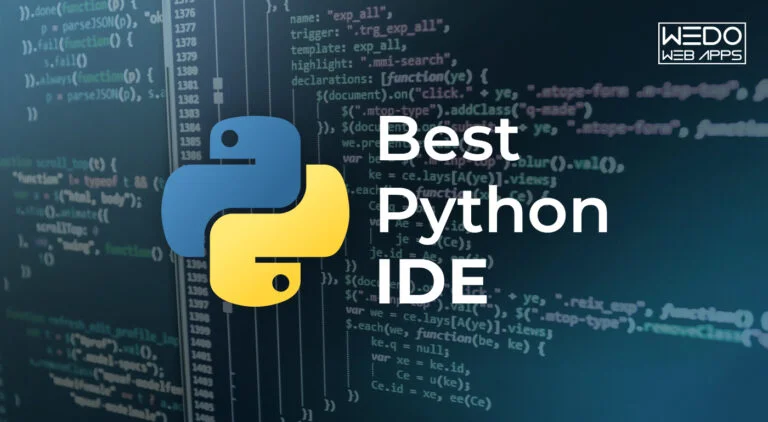12 Mar, 2024 | Web Development Company
The Best IDE for Python Programming

What is an IDE?
An IDE goes beyond a simple text editor. It's a comprehensive software suite that bundles a code editor, debugger, project manager, and other helpful features into a single interface. This translates to a streamlined workflow, allowing you to write, test, debug, and refine your Python code efficiently.Top Best IDE for Python Programming
Now, let's explore some of the most popular best Python IDEs, highlighting their strengths and target audiences:- PyCharm: Developed by JetBrains, PyCharm reigns supreme as a feature-rich IDE. Both free and paid versions are available. PyCharm boasts intelligent code completion, seamless debugging, version control integration, and built-in testing tools. Its extensive support for scientific libraries makes it a favorite among data scientists. However, PyCharm can be resource-intensive, so ensure your computer meets the system requirements. (Target Audience: Beginners, Intermediate, Advanced)
- Visual Studio Code (VS Code): This versatile, open-source IDE by Microsoft has become a developer darling. While not exclusively for Python, VS Code offers a lightweight and customizable experience. Install the Python extension to unlock features like syntax highlighting, debugging, and linting (code analysis for identifying potential errors). VS Code's extensive marketplace allows you to tailor the IDE to your specific needs with additional extensions. (Target Audience: Beginners, Intermediate, Advanced)
- Thonny: Designed with beginners in mind, Thonny offers a user-friendly interface and a built-in Python interpreter. This means you can start coding without any additional setup. Thonny's step-by-step debugging and visual tools like a debugger window make it ideal for learning the ropes of Python programming. (Target Audience: Beginners)
- Spyder: Another open-source option, Spyder excels in the realm of scientific computing. It integrates seamlessly with popular data science libraries like NumPy, SciPy, and Matplotlib. Spyder's variable explorer allows for interactive inspection of data, while its built-in plotting tools help visualize your results. (Target Audience: Intermediate, Advanced - Data Science)
- IDLE: This is the default IDE that comes bundled with Python installations. While lightweight and suitable for beginners, IDLE offers a more basic set of features compared to other options on this list. However, it's a good starting point to get familiar with the core Python development environment. (Target Audience: Absolute Beginners)
Beyond the Big Names: Exploring Other Options
The Python IDE landscape extends beyond these popular choices. Here are a few others worth considering:- Eclipse + PyDev: This combination leverages the powerful Eclipse IDE with the PyDev plugin specifically designed for Python development. PyDev offers robust debugging tools, code analysis, and web framework support. However, the setup process might be slightly more complex for beginners. (Target Audience: Intermediate, Advanced)
- Sublime Text: This premium code editor offers a fast and customizable experience. While not a full-fledged IDE, it can be enhanced with Python-specific plugins to provide features like code completion and debugging. Sublime Text appeals to developers who prefer a lightweight and highly configurable environment. (Target Audience: Intermediate, Advanced)
- Jupyter Notebook: While not strictly an IDE, Jupyter Notebook is a popular choice for data science and interactive Python coding. It allows you to create notebooks that combine code, visualizations, and explanatory text in a single document. This makes it ideal for data exploration and sharing your work with others.
IDE Features Comparison
| Feature | PyCharm | VS Code | Jupyter Notebook | Spyder | Thonny |
|---|---|---|---|---|---|
| Code Completion | Yes | Yes | No | Yes | Yes |
| Debugging | Yes | Yes | Yes | Yes | Yes |
| Integrated Git | Yes | Yes | No | No | No |
| Plugin Support | Yes | Yes | Limited | Yes | No |
| Platform Support | Multi | Multi | Web-based | Multi | Multi |
Key Considerations When Choosing a Python IDE
Before diving into specific options, consider these factors to tailor your search:- Experience Level: Are you a seasoned programmer or a budding Python enthusiast? Some IDEs cater more towards beginners with a gentle learning curve, while others offer advanced features for experienced developers.
- Project Type: What kind of Python project are you tackling? Data science applications might benefit from an IDE with scientific libraries integration, while web development projects might prioritize framework-specific support.
- Features: Make a list of functionalities important to you. Do you need robust debugging tools? Version control integration? Built-in testing frameworks? Prioritize the features that will enhance your specific workflow.
- Budget: Some IDEs are completely free and open-source, while others offer paid versions with additional functionalities.
- Read Reviews and Watch Tutorials: Online resources abound with user reviews, comparisons, and video tutorials for popular Python IDEs. Take advantage of these to gain insights and see the functionalities in action.
- Consider Your Learning Style: Do you prefer a visual interface with step-by-step debugging like Thonny, or a more code-centric approach offered by VS Code? Understanding your learning style can help narrow down your choices.
- Start Simple, Scale Up: If you're a beginner, starting with a user-friendly IDE like IDLE or Thonny can ease you into Python programming. As you gain experience, you can explore more feature-rich options like PyCharm or VS Code.
- Community and Support: A strong community around an IDE can be invaluable. Look for options with active forums, documentation, and tutorials to get help when needed.
The Final Word
The perfect Python IDE awaits! By understanding your needs, exploring the available options, and utilizing the tips provided, you'll be well-equipped to make an informed decision. Remember, the most important factor is choosing an IDE that empowers you to write, debug, and refine your Python code efficiently and productively. Happy coding!Frequently Asked Questions
Read reviews, watch tutorials, consider your learning style, start simple and scale up, and choose an IDE with a strong community for support.
Absolutely! Explore Eclipse + PyDev (powerful, plugin-based), Sublime Text (customizable code editor), and Jupyter Notebook (data science, interactive coding).

